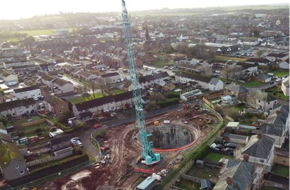Highlights
- Use of carbon accounting tool to reduce impacts from construction
- Significant reduction in carbon over a range of different projects
- Thorough accounting of carbon embedded in materials and transport
- Principle of applying carbon management at design stage has yielded significant savings
- Excellent community engagement before and during works

Amey – Binnies are committed to good environmental performance and to enhance the lives of the residents of the communities in which they operate.
As part of this commitment, they have achieved significant carbon reductions in their Wastewater capital alliance programme of construction works, by including the use of a carbon accounting tool. This tool requires scrutiny of the projects through the design phase adopting the principles of the Design Development Carbon Reduction Hierarchy; Don’t build, Build less, Use materials with low embodied carbon, Use less materials.
Overall, they were able to achieve a 26% reduction in carbon emissions for all works carried out over a 1-year period. Individual projects returned different carbon savings, due to the nature of the works undertaken. Having set a target of 10% carbon reductions, the figure of 26%, overall was a significant achievement. The best performing projects offered savings of 51% and 32% respectively.
Emissions are calculated for materials and components, looking at both their production and transport. The emissions are also calculated for the engineering works, whether temporary or permanent.
Changes to the design of projects that resulted in carbon savings included:
- Peat management – Minimize peat removal off site through peat management plan and floating road design
- Reduced temporary works i.e. over-pumping
- Shallower depth of construction, reduced trench widths
- Re-use of existing infrastructure
- Changes to pipe material and redesign of chambers
Amey-Binnies are conscious of the impacts their engineering works can have on local communities and aim to deliver excellent customer engagement before and during works. Regular progress updates are provided for local communities, through a variety of methods, including social media, information boards, contact centres, one-to-one visits and public information events. They regularly engage with community groups, to deliver benefits to the local community that are in addition to the main project.